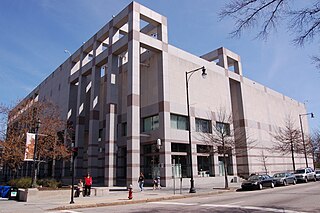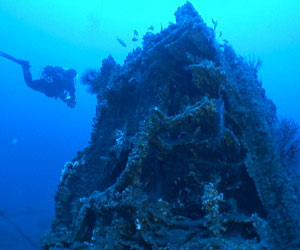Related Research Articles

A museum is an institution dedicated to displaying and preserving culturally significant objects. Many museums have exhibitions of these objects on public display, and some have private collections that are used by researchers and specialists. Compared to a library, a museum hosts a much wider ranges of objects and usually focus around a specific theme such as the arts, science, natural history, local history, and other topics. Public museums that host exhibitions and interactive demonstrations are often considered to be tourist attractions, and many museums attract large numbers of visitors from outside their host country, with the most visited museums in the world regularly attracting millions of visitors annually.

Roanoke Island is an island in Dare County, bordered by the Outer Banks of North Carolina. It was named after the historical Roanoke, a Carolina Algonquian people who inhabited the area in the 16th century at the time of English colonization.

The establishment of the Roanoke Colony was an attempt by Sir Walter Raleigh to found the first permanent English settlement in America. The colony was founded in 1585, but it was visited by a ship in 1590 and the crew found that the colonists had disappeared under unknown circumstances. It has come to be known as the Lost Colony, and the fate of the 112 to 121 colonists remains unknown to this day.

The Field Museum of Natural History (FMNH), also known as The Field Museum, is a natural history museum in Chicago, Illinois, and is one of the largest such museums in the world. The museum is popular for the size and quality of its educational and scientific programs, and its extensive scientific specimen and artifact collections. The permanent exhibitions, which attract up to 2 million visitors annually, include fossils, current cultures from around the world, and interactive programming demonstrating today's urgent conservation needs. The museum is named in honor of its first major benefactor, Marshall Field, the department-store magnate. The museum and its collections originated from the 1893 World's Columbian Exposition and the artifacts displayed at the fair.

The National Museum of American History: Kenneth E. Behring Center collects, preserves, and displays the heritage of the United States in the areas of social, political, cultural, scientific, and military history. Among the items on display is the original Star-Spangled Banner. The museum is part of the Smithsonian Institution and located on the National Mall at 14th Street and Constitution Avenue NW in Washington, D.C.

The National Cryptologic Museum (NCM) is an American museum of cryptologic history that is affiliated with the National Security Agency (NSA). The first public museum in the U.S. Intelligence Community, NCM is located in the former Colony Seven Motel, just two blocks from the NSA headquarters at Fort George G. Meade in Maryland. The motel was purchased, creating a buffer zone between the high security main buildings of the NSA and an adjacent highway. The museum opened to the public on December 16, 1993, and now hosts about 50,000 visitors annually from all over the world.

Hatteras Island is a barrier island located off the North Carolina coast. Dividing the Atlantic Ocean and the Pamlico Sound, it runs parallel to the coast, forming a bend at Cape Hatteras. It is part of North Carolina's Outer Banks and includes the communities of Rodanthe, Waves, Salvo, Avon, Buxton, Frisco, and Hatteras. It contains the largest part of the Cape Hatteras National Seashore. Prior to European settlement the island was inhabited by Croatoan Native Americans.

Hatteras is an unincorporated village and census-designated place (CDP) in Dare County, North Carolina, United States, on the Outer Banks island of Hatteras, at its extreme southwestern tip. As of the 2010 census it had a population of 504. Immediately to the west of the village of Hatteras is Hatteras Inlet which separates Hatteras Island from the neighboring Ocracoke Island. North Carolina Highway 12 passes through the community linking it to Frisco to the east and Ocracoke to the west.

The Mariners' Museum and Park is located in Newport News, Virginia, United States. Designated as America’s National Maritime Museum by Congress, it is one of the largest maritime museums in North America. The Mariners' Museum Library, contains the largest maritime history collection in the Western Hemisphere.
Graveyard of the Atlantic is a nickname for the treacherous waters and area of numerous shipwrecks off the Outer Banks of North Carolina, United States, which are due to the coast's shifting sands and inlets. To a lesser degree, this nickname has also been applied to Sable Island off of Nova Scotia, Canada, as well as the waters off Cape Cod, Massachusetts, United States.

Fort Raleigh National Historic Site preserves the location of Roanoke Colony, the first English settlement in the present-day United States. The site was preserved for its national significance in relation to the founding of the first English settlement in North America in 1587. The colony, which was promoted and backed by entrepreneurs led by Englishman Sir Walter Raleigh, failed sometime between 1587 and 1590 when supply ships failed to arrive on time. When next visited, the settlement was abandoned with no survivors found. The fate of the "Lost Colony" was a celebrated mystery, although most modern academic sources agree that the settlers likely assimilated into local indigenous tribes.

Charles Dawson was a British amateur archaeologist who claimed to have made a number of archaeological and palaeontological discoveries that were later exposed as frauds. These forgeries included the Piltdown Man, a unique set of bones that he claimed to have found in 1912 in Sussex. Many technological methods such as fluorine testing indicate that this discovery was a hoax, and Dawson, the only one with the skill and knowledge to generate this forgery, was a major suspect.
Eleanor Dare of Westminster, London, England, was a member of the Roanoke Colony and the daughter of John White, the colony's governor. While little is known about her life, more is known about her than most of the sixteen other women who left England in 1587 as part of the Roanoke expedition.

The North Carolina Museum of History is a history museum located in downtown Raleigh, North Carolina. It is an affiliate through the Smithsonian Affiliations program. The museum is a part of the Division of State History Museums, Office of Archives and History, an agency of the North Carolina Department of Cultural Resources.

The Museum of the Albemarle is located in Elizabeth City, North Carolina. It serves as the northeastern regional branch of the North Carolina Museum of History. This area of North Carolina is sometimes considered the birthplace of English North America, with close proximity to Roanoke Island and the "Lost Colony" of 1585.

Monitor National Marine Sanctuary is the site of the wreck of the USS Monitor, one of the most famous shipwrecks in U.S. history. It was designated as the country's first national marine sanctuary on January 30, 1975, and is one of only two of the sixteen national marine sanctuaries created to protect a cultural resource rather than a natural resource. The sanctuary comprises a column of water 1 nautical mile (1.9 km) in diameter extending from the ocean’s surface to the seabed around the wreck of the Civil War ironclad, which lies 16 nautical miles (30 km) south-southeast of Cape Hatteras, North Carolina. Average water depth in the sanctuary is 230 feet (70 m). Since its sinking in 1862, the Monitor has become an artificial reef attracting numerous fish species, including amberjack, black sea-bass, oyster toadfish and great barracuda.
The Center for Maritime Archaeology and Conservation (CMAC) was created in May 2005 by the regents of Texas A&M University.

The Graveyard of the Atlantic Museum is a maritime museum that focuses on the maritime history and shipwrecks of the Outer Banks of North Carolina. The museum is located in Hatteras Village, the southernmost community on Hatteras Island, North Carolina, and opened in 2002.

The Museum of the Bible is a museum in Washington D.C., owned by Museum of the Bible, Inc., a non-profit organization established in 2010 by the Green family. The museum documents the narrative, history, and impact of the Bible. It opened on November 17, 2017, and has 1,150 items in its permanent collection and 2,000 items on loan from other institutions and collections.

The Kelsey Museum of Archaeology is a museum of archaeology located on the University of Michigan central campus in Ann Arbor, Michigan, in the United States. The museum is a unit of the University of Michigan's College of Literature, Science, and the Arts. It has a collection of more than 100,000 ancient and medieval artifacts from the civilizations of the Mediterranean and the Near East. In addition to displaying its permanent and special exhibitions, the museum sponsors research and fieldwork and conducts educational programs for the public and for schoolchildren. The museum also houses the University of Michigan Interdepartmental Program in Classical Art and Archaeology.
References
- ↑ Erin James (November 1, 2010). "The Lost Colony may now be found". The Virginian-Pilot. Retrieved November 2, 2010.
